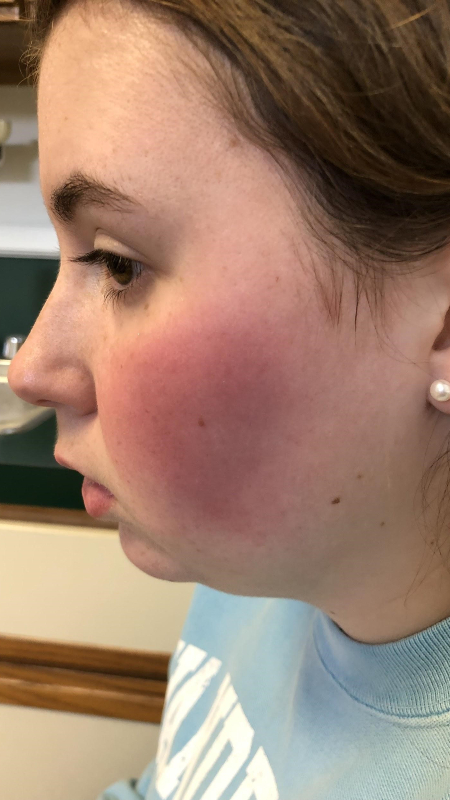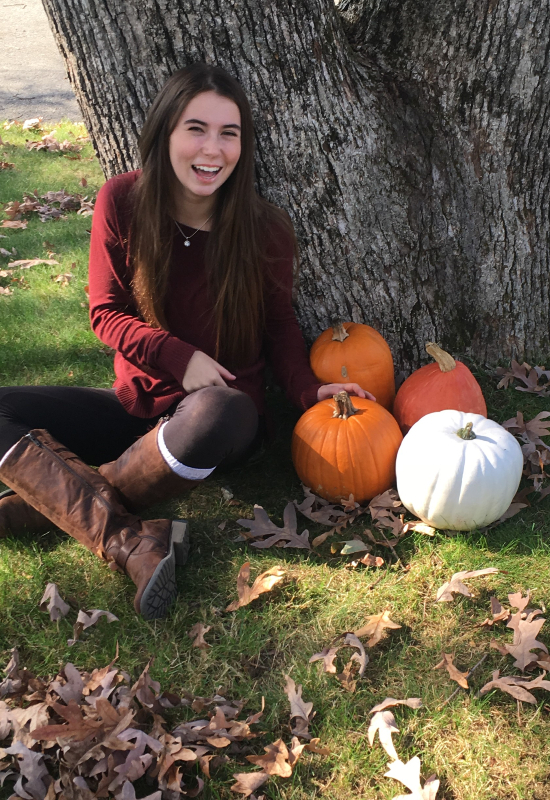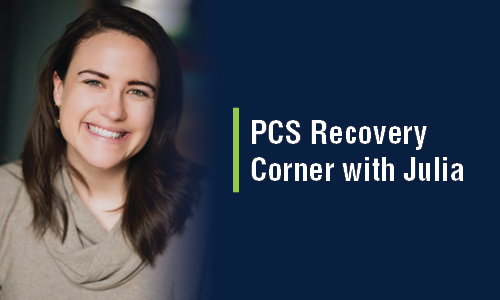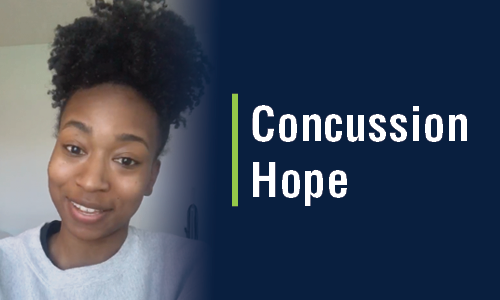Get Inspired
My Fight Against The Invisible Injury
The first day of August, 2017 was the day my life changed in a split second, and I would begin to face a journey that would forever change me.
I was 13 and at gymnastics training on the trampoline. I hit my forehead with my own two knees, and then came crashing down onto my neck. An instant headache occurred, but without thinking too much of it, I finished practicing and then headed home. Three days later, my headache still hadn’t subsided. I went to my pediatrician who was not completely convinced that it was a concussion but instructed me to take it easy and see what happens. For the next seven days I continued to go to gymnastics practice, watch TV, use electronics, and do everything I would normally do even though I didn’t feel right. I continued to swing around the bars, flip through the air, and at one practice, even fell off the bars and hit my head a second time.

Posted: June 13, 2019
As time went on, my headaches became rather unbearable and I could no longer tolerate gymnastics. So, 10 days after the initial incident, we went to the emergency room where it was confirmed that I did indeed have a concussion and could be at risk of developing Post-Concussion Syndrome (PCS). At that point we knew something more serious was going on than we thought and took all precautions.
With my headaches persisting and new sensitivities to light, sound, temperature and motion, I spent the next couple of months sleeping a lot, staying up in my room, and isolating myself from the outside world. I wasn’t quite sure what was going on, or what to do. We started to search for more doctors who could give us advice or guidance on treatments, as well as more information about concussions and PCS. Much of the time we got conflicting information and opposing advice. I started to realize not many people knew exactly what was going on in my brain, or what was causing my continued head and neck pain.

I had to miss starting high school for the first month, which is when you form most of your new friendships. I had a short period of time after seeing an acupuncturist when I felt better and returned to school, but the headaches soon returned. A few months after that, we were referred to a pain clinic as my headaches continued and I was medically deteriorating. We were hoping for a miracle.

The pain rehab program ended up doing much more harm than good because they did not understand PCS. The theory behind this program is to push through your pain, but it pushed me so far above my threshold that it ended up leaving me in a very bad place for a very long time. I had trouble just walking around school and got winded going up and down stairs. I spent most of the time at school in the nurses or guidance offices.
Deciding to Leave School
I was pushed not to leave school early, would only be allowed short breaks, and was strongly encouraged to take a computer technology class even when screen time was so difficult for me. As an athlete, I was used to being in the gym for many hours several days a week and learning to push through fears and pain on a regular basis. I could not understand why this recovery was so hard for me.
On the advice of the pain rehab program, I even went on a cross country flight to Hawaii as a “therapeutic” getaway. Neither I nor my family felt comfortable with the idea, but we tried anyway. With all the stimulation, decreased oxygen levels on the plane, crowds, loud noises, and lengthy plane ride it proved to be so far over my activity threshold that it sent me into a downward spiral that took me over a year to get out of. It was traumatic and not enjoyable at all. While there, my pain got so unbearable, that for the first time I felt truly hopeless and like I could no longer live this way.
I spent the next several months in and out of school, with my pain still worsening. I tried several different medications, many of which had scary side effects that were even worse than my symptoms. We investigated a multitude of treatments and everything under the sun to try and get some relief, even post-traumatic stress therapies. Car rides made me sick, but staying home was isolating. There were times when I would scream out loud for help due to the pain and other times I would go into my basement and scream into a pillow. I would refuse to go near a TV or sounds, even music or people talking. I would refuse to leave the house. The pain and distress escalated to the point where I was becoming someone I didn’t even recognize.
I could not accept what was happening to me. I felt like no one could help me, none of the treatments were working, and every doctor would say to “give it time,” but I felt like I could barely make it through each day. It was an everyday battle fighting negative thoughts and trying to stay positive. I was angry and irritable at times, and for a while, I could not see a future for myself.
The more I went to school, the worse my headaches got. After a while it got to the point where I was present at school, but not participating. That’s when we decided I should stop going, and I ended up leaving my freshman year and completing the work at home in small doses over the summer. I missed out on the entire high school experience. My friends from home and the gym started to forget about me and my coach didn’t understand how my recovery could possibly be taking so long.
A Burst of Hope
One night, I believe I got a gift from God. My mom and I were researching when we stumbled across the Concussion Legacy Foundation website, where we found stories of kids just like me. Before then, I had no idea that a concussion could last so long or be so severe. I was insistent that it couldn’t “just” be a concussion, and something more serious had to be going on.
The website had so much valuable information and we learned so much about what was happening to me, and that it was normal. It gave me a burst of hope. That’s also when we found Dr. Cantu. Thanks to Dr. Cantu, I was diagnosed with “dysautonomia,” a common PCS symptom that went unnoticed by several doctors. It helped to explain a lot of mysterious symptoms.

Dysautonomia is a term that describes what happens when your autonomic nervous system becomes dysregulated. This affected my heart rate, blood pressure, and temperature control and explained why I was having so much trouble with any physical activity. It also gave me flushing and burning of my face and hot and cold spells.
I had to be put on a Beta Blocker to control my blood pressure and use ice packs on my head, cheeks and even sometimes my feet to keep me cool! Since your brain controls all of your body functions, really anything can be affected by a concussion. I have also had issues with my endocrine system which controls hormones. My cortisol levels increased due to stress, which can contribute to weight gain and make other symptoms worse.
The truth about PCS is that there aren’t enough doctors, clinicians, coaches or parents that fully understand it. After discovering the Concussion Legacy Foundation website, Dr. Cantu, and the Headache Clinic at Boston Children’s Hospital, we could finally start the recovery process appropriately.
Tallying My Symptoms and Treatments
During this process I have celebrated 2 birthdays, missed most of freshman year and all of sophomore year. I have seen over 45 different doctors/ medical personnel, including four acupuncturists, six PT’s, five neurologists, one neurosurgeon, one hypnotist, five psychologists, one psychiatrist, four orthopedists, two cardiologists, one endocrinologist, one craniosacral therapist, four massage therapists, three pediatricians, three chiropractors, and two vision therapists. This does not include medical personnel from a few hospital stays! I have received nearly 200 various painful injections (not including acupuncture which does not hurt!) to my forehead, head, temples, neck, shoulders, and the bridge of my nose.
Note: CLF does not endorse all the therapies described above. Consult your doctor for a personalized treatment plan. Click here to learn about evidence based PCS therapies.
My Recovery and Message to Others
And finally, the good news. About a year after my injury, my headaches started to get less severe. It appeared the treatments were helping. That was my turning point. And then, a few months later, what really pushed me over the edge in my recovery was when I began seeing a Manual Physical Therapist. He was able to feel things that do not appear on any MRI. He was able to gently correct a misalignment of my skull and neck joints that no one else had discovered. I am now a year and a half post injury and feeling better every day. I still have a long road ahead to achieve full recovery and return to school and sports, but I can finally see the finish line and I want others to know that it can happen for them too!

The reason I am sharing my story, and all of my hardships with PCS, is not to scare, but rather to spread awareness of how serious it can be. Before I had PCS myself, I knew nothing about concussions and didn’t know PCS was even a “thing” and now it has consumed my life for nearly two years. PCS affects all aspects of your life and your entire family. Few people fully understand this injury, because it’s invisible. At school kids would say things like “concussions can’t last that long,” or “I had a concussion and it only lasted a couple days,” or “you’re so lucky you get to miss school.” I had some of my friends and acquaintances wonder if I was faking or exaggerating. Classmates would stare at me. Little did they know what my life was really like.

My best advice for anyone going through this is to keep trying until you find something that works for you, never give up hope, and always trust and follow your instincts. You may need to stretch out of your comfort zone but don’t push yourself too hard. Seeking out others who know what you are experiencing is important. Whatever your faith is, don’t stop believing, even if you have moments of doubt. I received over 100 cards, letters and gifts from family, friends and a nation-wide prayer group which was a big comfort. PCS can be overcome and now my focus is on helping as many other people as possible.
Do you or someone you know need help dealing with a concussion or PCS? Click here to fill out our Help Request Form and a dedicated Concussion Legacy Foundation staff member will be in touch as soon as possible. We'll do our best to get you the help you need.
You May Also Like

It is easy to feel misunderstood with PCS. CLF's Julia Manning gets it. She suffered from PCS for several years and opens up about the hardest parts, plus the coping strategies and treatment tips she picked up along the way.
PCS Recovery Corner
Your PCS will get better, and recovery is possible. Holding on to that hope is key. Get inspired with video messages from dozens of others who have battled PCS.
Concussion Hope Videos